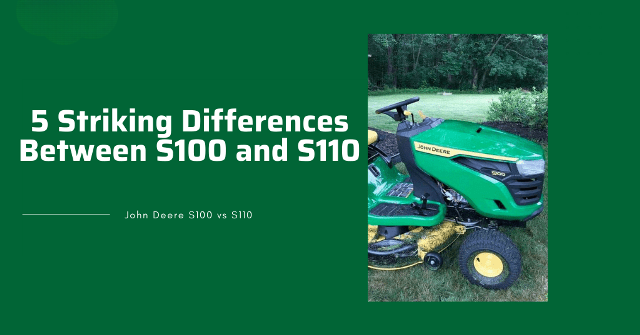What to Look for When Choosing Between the John Deere S100 and S110
The John Deere S100s are relatively new to the company’s lineup of lawn tractors, having debuted to the market in 2021, and have since gone on to dominate suburban and suburban backyards. The S100s debuted with a more futuristic look with few changes from the E series, confirming a better and simpler mowing experience.
Both the S100 and the S110 are considered entry-level models in the series, but they have subtle differences that could be crucial when choosing a mower for your specific needs.
The John Deere S110 model is superior to the S100 model because the John Deere S110 model emphasizes specific enhancements more than the S100 model. The S110 is the best mower for your hilly or rocky lawn. They are, however, more costly than the S100, so this is something to keep in mind as you plan your budget. In spite of the fact that both lawn tractors perform admirably, tailoring the discussion to your specific needs increases the likelihood that you’ll find the ideal solution.
In this essay, I will compare the S100 and S110 so that you can easily determine which lawn tractor will serve you best in any given situation.
Table of Contents
5 Major Distinctions Between The John Deere S100 And S110.
Depending on your preferences, you can select a riding mower with fewer or more functions. It’s not always the case that you’d benefit most from a brand-new feature or an improved version of an existing one. This is what you would have access to:
A Distinction In Horsepower
Lawn tractors’ power is one of the machine’s most notable aspects, and it can serve as a useful criterion for making a purchase.
The S110 has 19 horsepower, while the S100 has only 17. Though there are times when it’s unnecessary to shell out for a more powerful riding mower, it’s always advisable to go with the most powerful one available. In other words, the S100 is fine if you have a lawn that is around half an acre in size and has a reasonable amount of grass. The S110’s extra 2 hp will make mowing much more pleasant; you won’t have as much trouble with slopes, and wet or damp grass won’t be as big of a problem.
As an added bonus, the S110 lawn tractor is an upgrade over the S100 when it comes to snow plowing.
Features of the Seating
If you were to locate an S100 and an S110 side by side, this would be the first noticeable change. The S100 has the very worst saddles in the world! The one-piece seats are standard equipment for residential lawn tractors but provide no more than basic convenience. There is almost little back support, no airflow to the rear, and an absurd suspension system to smooth out imperfections in the yard.
To make matters worse, as time passes, the plastic used to construct the seats will wear and fracture, enabling water to leak in and further deteriorate the structure. I’ve tried to look at the positive aspects of the one-piece seat, but I always find myself disappointed.
The S110, thankfully, has upgraded seating. The 15-inch two-piece seat has higher-quality padding and is more comfortable to sit on. Even though they are the better option, sitting on them for more than 2 hours can become tiresome. Adding a suspension seat to your lawn tractor, and particularly the S100, is the finest option. To help you narrow down your options, I have produced an article comparing some of the top suspension seats on the market.
Different Varieties of Motors
Lawn caretakers often look to the lawn tractor’s engine for reassurance and assurance. Both versions include Briggs & Stratton engines, which will be recognizable to customers.
In contrast to the S110’s V-twin cylinders, the S100 only has a single cylinder. For light yard work, a single-cylinder motor has the advantage of using less gas. Although four-cylinder engines are common, V-twin cylinder engines have many advantages.
Both models are suitably powered for your yard in terms of size and features because their fuel consumption and efficiency are commensurate with their motor horsepower. The S100 will provide adequate power for your needs while using less fuel for yards smaller than 1 acre. To mow more than an acre, the S110 will need more gasoline, but its power is more than adequate for the job.
Transmitting
There is a functional and brand-name distinction between the transmission units of the two versions. The Kanzaki Tuff Torq hydrostatic double-wheel gearbox is standard on the S100. The S110, on the other hand, has a Tuff Torq TL200, which is a hydrostatic 2-wheel transmission. The S110 tranny unit is noticeably more powerful than the S100, yet it is also more agile and can scale steeper terrain with greater ease. On top of that, they’ll be more effective when faced with difficult mowing conditions, such as mowing tough turf or damp grass.
Both versions’ transmission units are subpar and will fail just as easily if you put too much demand on them, so pick your poison carefully. Although both transmission units work similarly, the S110 has a longer lifespan.
Price
The S100 can be had for around $2,000, while the S110 can be had for around $2,400, with the difference between the two versions being a few hundred dollars.
John Deere S100 and S110 Share 5 Key Features and Norms
Both models have obvious resemblance. Here, though, are some of the most important parallels to keep in mind as you make your choice:
Inverter With PTO Switch
By using the PTO switch, you can activate and deactivate the lawn tractor’s cutting attachment. In order to manually engage or disengage the blades, you must swerve the machine either horizontally to the left or right and use the PTO lever included with both versions.
In comparison, electric PTO switches in the shape of pop-up buttons, which can be pushed or pulled to operate the blades, are used in models starting with the S130 and upwards. The manual operators would be preferable to electric PTOs because they would last longer; electric PTOs need to be replaced after only three years of use.
Speed
The speed at which these lawn tractors operate is independent on the type of engine or transmission used, as you will find.
Both the S100 and S110 are capable of 5.5 mph in the forward direction and 3.2 mph in the reverse. Depending on the layout of your lawn (including slopes and obstructions), you could mow an acre in about 1.5 hours. The advantage of this pace is that the cut will be considerably more precise than it would be if you were running 8 or 9 miles per hour. The adage “less is more” certainly applies in this circumstance.
Size of Tires and Grip
The front tires on the S100 and S110 are sized at 15 by 6 by 6 inches, and the rear tires are sized at 20 by 8 by 8 inches. This value shouts how elementary the pull is. Both vehicles are useless in temperatures above 13 degrees and doing so is a bad joke that could lead to a collision. If your yard has a lot of inclines and declines, you can adjust the tire pressure so that you can drive more easily over the uneven terrain.
The Size, Shape, and Quality of the Deck Cut
In both cases, the deck size and material will be a conventional 42 inches in width and 13 gauges in thickness of stamped steel. Amazingly, despite having only two anti-scalp wheels, the decks are able to make clean cuts; you won’t notice any stragglers, turf tearing, or uneven mowing as you zoom by. The decks aren’t particularly high-tech, but they get the job done well and alleviate the hassle of re-mowing worn areas.
Warranty
You may take advantage of the same 24-hour, two-year bumper-to-bumper warranty on both the S100 and S110 lawn tractors, as they are both classified as residential grade. You probably won’t need it too often, though, because John Deere tractors are built to last. Mowers can be used for as long as feasible without severe breakdowns if they are cared for properly.
FAQs
Do the John Deere S100 and S110 Have the Capacity to Tow?
As long as it fits inside the lawn tractor’s towing capacity, you may pull anything with it. Keep in mind that the transmission system isn’t the strongest on the market, so you should only hook up the bare essentials for towing or pushing.
For how much weight can the John Deere S100 and S110 be towed?
Your JD model is capable of no more than 400 Ibs of towing weight. When pulling your mower, it’s best not to exceed 350 pounds to keep it running smoothly and for as long as it should.
How Long Do Lawn Tractors Like The John Deere S100 And S110 Usually Last?
If cared for properly, your John Deere S100 or S110 might live as long as nine years.
Can I Use a John Deere S100 or S110 Tractor to Remove Snow?
You can use your JD lawn tractor to clear snow, but only if you don’t have to push or pull more snow than the mower can handle. To extend the life of the lawn mower, all you need to do is “snow shove” the driveway sometimes.
The Final Thoughts
Both the S100 and the S110 are sturdy and effective lawn tractors, ideal for a home setting. However, the S110 is the superior model because of its enhanced features and durability. I urge you to carefully weigh your needs; you may find that the S100 is all you really want and then some, allowing you to make a smart financial decision. Overall, I hope you have a wonderful journey.
More about: John Deere Mower








